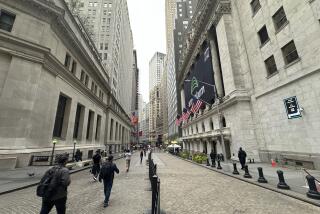Stocks Fall in Heavy Trading, U.S. Bonds Up
U.S. bonds rose for a second day Friday, as tumbling world stock markets pushed investors to the relative safety of U.S. Treasury securities.
In the U.S., stocks fell broadly in the second most-active session ever, but avoided a rout that appeared to be taking shape when trading started.
The Dow Jones industrial average lost 90.21 points to 7,756.29 after falling 111 points Thursday. Trading volume was the second-highest in New York Stock Exchange history at 782 million shares, behind the 1.2 billion traded on Oct. 28, the day after the Dow fell 554 points.
The Nasdaq composite rose 1.55 points to 1,524.74. Other broad indexes were lower, however; the NYSE composite lost 4.30 to 497.39, while the Standard & Poorâs 500 index shed 8.52 points to 946.78.
The sell-off reflected worries among investors that American corporations would see their profits suffer because of the Asian crisis.
Although events in Asia are disturbing, some analysts and traders minimized the importance of Fridayâs session, saying the drop was worsened by the quarterly triple expiration of options and futures contracts that tends to increase price swings.
But stocksâ decline prompted a wholesale flight to safety to bonds.
âThe bond market looks good,â said William Gross, who oversees $110 billion of bonds at Pacific Investment Management Co. in Newport Beach. He sees 30-year yields falling to 5.5% in 1998. That would be the lowest since the government began regular bond sales in 1977; the record low now is 5.78%, set on Oct. 15, 1993.
The benchmark 30-year bond climbed higher, pushing its yield down 1 basis point to 5.92%, matching the four-year low reached last Friday. On Thursday, the bond yield sat at 5.93%.
Treasuries began climbing in overseas trading as Asian stock markets slumped. Japanâs benchmark Nikkei 225 index fell 5.2% after food trader Toshoku filed for bankruptcy, fueling concern that more Japanese companies may collapse. Hong Kongâs Hang Seng stock index fell 3.2%, while South Koreaâs Kospi index plunged 5.1%.
Among Fridayâs highlights:
* In the latest fallout from the Asian crisis, Nike said this week its latest quarterly profit fell 20% and next yearâs profit would be less than Wall Street has been expecting. The company cited softening demand for its shoes and clothes, especially in Asia. Nike stock dropped $2.25 before recovering, ending the day up 13 cents at $40.13.
* Beaten-down technology shares rose, helping the market recoup most of its losses. IBM gained $2.13 to $102.13. Intel advanced 88 cents to $70, and Applied Materials added $1.88 to $30.
But 3Com fell 50 cents to $32.63 after reporting that earnings fell 91% in its second fiscal quarter, hurt in large part by slowing sales in Asia. Before it warned of a shortfall last month, analysts had expected 46 cents.
* General Electric raised its stock buyback program by $4 billion to $17 billion, the same increase it announced a year ago. GE fell $1 to $73. For some traders, the timing of GEâs announcement recalled a similar move by IBM on Oct. 28, the day after the Oct. 27 rout, when the Dow fell 554 points.
Market Roundup, D4
More to Read
Inside the business of entertainment
The Wide Shot brings you news, analysis and insights on everything from streaming wars to production â and what it all means for the future.
You may occasionally receive promotional content from the Los Angeles Times.










